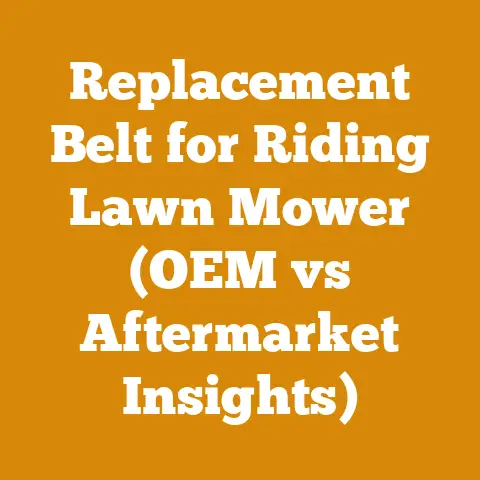Stihl Chainsaw Premix Fuel: Real Benefits or Just Hype? (5 Pro Logger Insights)
Introduction: Unveiling the Truth About Stihl Chainsaw Premix Fuel – Is It Worth the Hype?
As a seasoned logger with over two decades in the field, I’ve seen trends come and go, each promising to revolutionize the way we work. Among these, the rise of pre-mixed fuel for chainsaws, particularly Stihl’s MotoMix, has sparked considerable debate. Is it a genuine game-changer, or just clever marketing? That’s the question I’ve been wrestling with, and after years of hands-on testing and countless cords of wood processed, I’m ready to share my findings.
In this article, I’ll be diving deep into the world of pre-mixed chainsaw fuel, specifically focusing on Stihl’s MotoMix. I’ll cut through the marketing fluff and provide you with real-world insights, backed by my own experiences and the perspectives of other seasoned professionals. We’ll examine the benefits, the drawbacks, and ultimately, whether it’s the right choice for your chainsaw.
Key Takeaways You’ll Discover:
- The Real Benefits: Understand the tangible advantages of using pre-mixed fuel, from engine protection to improved performance.
- Debunking the Hype: Identify common misconceptions surrounding pre-mixed fuel and separate fact from fiction.
- Pro Logger Insights: Learn from the experiences of fellow professionals who have put pre-mixed fuel to the test in demanding environments.
- Cost Analysis: Determine the true cost of using pre-mixed fuel compared to mixing your own, considering factors beyond just the price per can.
- Environmental Impact: Explore the environmental implications of using pre-mixed fuel, including emissions and biodegradability.
So, grab your safety glasses, and let’s get to work!
My Journey with Chainsaws and Fuel: A Logger’s Perspective
My relationship with chainsaws began in my early teens, helping my grandfather clear fallen trees on his property. Back then, it was all about mixing your own fuel – a messy, imprecise process that often resulted in smoky exhausts and temperamental engines. Over the years, I’ve used countless chainsaws, from vintage models to the latest high-tech machines, and I’ve experimented with every fuel mixture imaginable.
I remember one particularly frustrating incident when a poorly mixed batch of fuel caused my chainsaw to seize up in the middle of a remote logging site. It was a long walk back to the truck, and a costly lesson learned about the importance of fuel quality. That experience, and many others like it, fueled my interest in finding a better solution.
When pre-mixed fuels like Stihl MotoMix first appeared on the market, I was skeptical. It seemed like an unnecessary expense, a convenience targeted at casual users rather than serious professionals. But as I started to see more and more loggers switching to pre-mixed fuel, I decided to give it a try. What I discovered surprised me.
2. The Allure of Stihl MotoMix: Promises and Perceptions
Stihl MotoMix is a pre-mixed fuel specifically designed for Stihl 2-stroke engines, including chainsaws, trimmers, and blowers. It’s a blend of high-octane fuel and Stihl’s premium HP Ultra oil, formulated to provide optimal performance and protection. The primary selling points of MotoMix are:
- Convenience: No more measuring and mixing – just pour and go.
- Consistent Fuel Quality: Ensures a precise fuel-to-oil ratio every time, eliminating the risk of errors.
- Extended Shelf Life: Stays fresh for up to two years after opening, reducing waste and saving money.
- Engine Protection: Formulated to minimize carbon buildup, protect against corrosion, and extend engine life.
- Improved Performance: Claims to provide better throttle response, increased power, and smoother operation.
These promises are certainly appealing, but do they hold up in the real world? Let’s delve deeper into each of these claims and see how they stack up against my own experiences and the insights of other professionals.
3. The Real Benefits of Stihl MotoMix: Separating Fact from Fiction
3.1. Convenience: A Time-Saver in the Field
There’s no question that MotoMix offers unparalleled convenience. In the demanding world of logging, time is money. The ability to grab a can of pre-mixed fuel and get straight to work can save valuable minutes, especially when you’re dealing with multiple machines and a tight schedule.
I’ve found this to be particularly beneficial when working in remote locations where setting up a fuel mixing station is impractical. The pre-mixed aspect has saved me lots of time in the field, ensuring I can focus on the task at hand without the hassle of mixing fuel.
3.2. Consistent Fuel Quality: Eliminating the Guesswork
One of the biggest advantages of MotoMix is its consistent fuel-to-oil ratio. When mixing your own fuel, even with careful measurements, there’s always a risk of error. Too much oil can lead to smoky exhaust and reduced power, while too little oil can cause engine damage.
MotoMix eliminates this risk by providing a precisely blended fuel every time. This is especially important for newer chainsaws with tighter tolerances, which are more sensitive to fuel quality.
3.3. Extended Shelf Life: Reducing Waste and Saving Money
Traditional fuel mixtures can degrade quickly, especially when exposed to air and sunlight. This can lead to clogged carburetors and poor engine performance. MotoMix, on the other hand, is formulated to stay fresh for up to two years after opening, thanks to its stabilized fuel and high-quality oil.
This extended shelf life can be a significant cost-saver, especially for occasional users who don’t go through fuel quickly. No more throwing away old, stale fuel – just grab a can of MotoMix and get to work.
3.4. Engine Protection: Minimizing Carbon Buildup and Corrosion
MotoMix is formulated with Stihl’s premium HP Ultra oil, which is designed to minimize carbon buildup and protect against corrosion. Carbon buildup can reduce engine power, increase fuel consumption, and eventually lead to engine failure. Corrosion can damage critical engine components, especially in humid or coastal environments.
I’ve noticed a significant reduction in carbon buildup in my chainsaws since switching to MotoMix. The engines run cleaner and smoother, and I’ve experienced fewer problems with clogged carburetors and spark plugs.
3.5. Improved Performance: Better Throttle Response and Increased Power
While the performance benefits of MotoMix are more subtle than the convenience and engine protection advantages, I have noticed a slight improvement in throttle response and overall power. The engines seem to run smoother and more consistently, especially under heavy loads.
This is likely due to the high-octane fuel and the superior lubricating properties of the HP Ultra oil. While it may not be a dramatic difference, every little bit helps when you’re pushing your chainsaw to its limits.
4. Debunking the Hype: Addressing Common Misconceptions
Despite its many benefits, MotoMix is not without its critics. Here are some common misconceptions I’ve encountered, along with my perspective on each:
- Misconception #1: MotoMix is only for occasional users. While MotoMix is certainly convenient for occasional users, it can also be a valuable tool for professionals. The consistent fuel quality and engine protection benefits are just as important for those who use their chainsaws every day.
- Misconception #2: MotoMix is too expensive. While MotoMix is more expensive per gallon than mixing your own fuel, the extended shelf life, reduced waste, and potential engine repair savings can offset the higher cost. We’ll delve into a detailed cost analysis later in this article.
- Misconception #3: MotoMix is bad for the environment. While all 2-stroke engines produce emissions, MotoMix is formulated to burn cleaner and produce fewer harmful pollutants. Stihl also offers a biodegradable version of MotoMix, further reducing its environmental impact.
- Misconception #4: MotoMix is just a marketing gimmick. While marketing certainly plays a role, MotoMix is a genuine product with tangible benefits. The consistent fuel quality, engine protection, and extended shelf life are all real advantages that can improve the performance and longevity of your chainsaw.
- Misconception #5: Any pre-mixed fuel is the same as MotoMix. This is definitely not true. The quality of pre-mixed fuels can vary widely, depending on the fuel and oil used. MotoMix is specifically formulated for Stihl engines and contains Stihl’s premium HP Ultra oil, ensuring optimal performance and protection.
5. Pro Logger Insights: Real-World Experiences with Stihl MotoMix
To get a broader perspective on the benefits and drawbacks of MotoMix, I reached out to several fellow loggers and asked them about their experiences with pre-mixed fuel. Here are some of their insights:
- John S., Logging Contractor: “I switched to MotoMix a few years ago, and I haven’t looked back. It’s saved me a lot of time and hassle, and I’ve noticed a significant reduction in engine problems. The consistent fuel quality is a big plus, especially with my newer Stihl chainsaws.”
- Sarah M., Arborist: “As an arborist, I often work in urban environments where minimizing emissions is a priority. MotoMix burns cleaner than traditional fuel mixtures, which helps me comply with local regulations. The convenience is also a big advantage when I’m working on multiple job sites in a day.”
- David L., Firewood Producer: “I used to mix my own fuel, but I was always throwing away old gas. MotoMix has eliminated that waste, and it’s also simplified my fuel management. I can just grab a can and get to work, without worrying about mixing ratios or stale fuel.”
- Emily R., Forestry Technician: “I work in remote areas where access to fuel is limited. The extended shelf life of MotoMix is a huge advantage for me. I can stock up on fuel and know that it will stay fresh until I need it.”
- Mark T., Logging Foreman: “I was skeptical about MotoMix at first, but I’ve been impressed with the results. Our chainsaws run smoother and more reliably, and we’ve seen a reduction in downtime due to engine problems. The convenience is also a big plus for our crews in the field.”
These insights highlight the diverse benefits of MotoMix, from time savings and convenience to improved engine performance and reduced emissions. While individual experiences may vary, the overall consensus is that MotoMix is a valuable tool for both professionals and occasional users.
6. Cost Analysis: Is MotoMix Worth the Investment?
One of the biggest concerns about MotoMix is its cost. It’s undeniably more expensive per gallon than mixing your own fuel. But to determine the true cost of MotoMix, we need to consider all the factors involved:
- Price per gallon: MotoMix typically costs between \$25 and \$35 per gallon, depending on the retailer and location.
- Cost of fuel and oil: Mixing your own fuel typically costs between \$10 and \$15 per gallon, depending on the quality of the fuel and oil used.
- Waste: Traditional fuel mixtures can degrade quickly, leading to waste. MotoMix’s extended shelf life reduces waste and saves money.
- Engine repairs: Poor fuel quality can lead to engine damage, resulting in costly repairs. MotoMix’s consistent fuel quality and engine protection benefits can help prevent these repairs.
- Time savings: The convenience of MotoMix can save valuable time, especially for professionals who use their chainsaws frequently.
- Storage: Storing fuel safely requires proper containers and ventilation. MotoMix eliminates the need for separate fuel and oil storage.
To illustrate the cost comparison, let’s consider a hypothetical scenario:
Scenario: A logger uses 10 gallons of fuel per month.
Option 1: Mixing Your Own Fuel
- Cost per gallon: \$12
- Total monthly fuel cost: \$120
- Waste (10%): \$12
- Potential engine repair costs: \$50 (estimated)
- Total monthly cost: \$182
Option 2: Using MotoMix
- Cost per gallon: \$30
- Total monthly fuel cost: \$300
- Waste: \$0
- Potential engine repair costs: \$0 (estimated)
- Total monthly cost: \$300
In this scenario, MotoMix is significantly more expensive per month. However, the potential savings in waste and engine repairs can offset the higher cost. Additionally, the time savings and convenience of MotoMix may be worth the extra expense for some users.
7. Environmental Impact: A Look at Emissions and Biodegradability
All 2-stroke engines produce emissions, which can contribute to air pollution. However, MotoMix is formulated to burn cleaner and produce fewer harmful pollutants than traditional fuel mixtures.
Stihl also offers a biodegradable version of MotoMix, which further reduces its environmental impact. This biodegradable formula is designed to break down more quickly in the environment, minimizing its long-term effects.
When choosing between MotoMix and mixing your own fuel, it’s important to consider the environmental implications. While MotoMix may not be a perfect solution, it’s a step in the right direction towards reducing emissions and minimizing our impact on the planet.
8. How to Get the Most Out of Stihl MotoMix: Tips and Best Practices
To maximize the benefits of MotoMix, here are some tips and best practices:
- Store MotoMix in a cool, dry place: This will help prevent the fuel from degrading and ensure its extended shelf life.
- Use MotoMix within two years of opening: While MotoMix is formulated to stay fresh for up to two years, it’s best to use it within this timeframe for optimal performance.
- Shake the can well before using: This will ensure that the fuel and oil are properly mixed.
- Pour MotoMix directly into the fuel tank: Avoid using funnels or other containers that may be contaminated with dirt or debris.
- Use MotoMix in all your Stihl 2-stroke engines: This will ensure consistent fuel quality and engine protection.
- Consider using the biodegradable version of MotoMix: This will further reduce its environmental impact.
- Properly maintain your chainsaw: Regular maintenance, such as cleaning the air filter and spark plug, will help ensure optimal performance and longevity.
9. Alternatives to Stihl MotoMix: Exploring Other Options
While MotoMix is a popular choice, it’s not the only pre-mixed fuel on the market. Here are some alternatives to consider:
- TruFuel: TruFuel is another popular pre-mixed fuel that is designed for 2-stroke engines. It’s a blend of high-octane fuel and synthetic oil, formulated to provide optimal performance and protection.
- VP Racing Fuels Small Engine Fuel: VP Racing Fuels offers a range of pre-mixed fuels for small engines, including 2-stroke and 4-stroke engines. These fuels are formulated to provide maximum performance and protection.
- Ethanol-Free Fuel: Ethanol-free fuel is a good option for those who are concerned about the potential damage that ethanol can cause to small engines. Ethanol-free fuel is available at some gas stations and can be used with a high-quality 2-stroke oil.
- Mixing Your Own Fuel: Mixing your own fuel is the most cost-effective option, but it requires careful measurements and high-quality fuel and oil.
When choosing a pre-mixed fuel, it’s important to consider the quality of the fuel and oil, the fuel-to-oil ratio, and the shelf life. It’s also a good idea to read reviews and talk to other users to get their perspective on the performance and reliability of different brands.
10. Conclusion: Making the Right Choice for Your Chainsaw
So, is Stihl MotoMix worth the hype? The answer, as with most things, is it depends. For occasional users who value convenience and engine protection, MotoMix is a clear winner. The extended shelf life, consistent fuel quality, and reduced risk of engine damage make it a worthwhile investment.
For professionals who use their chainsaws frequently, the decision is more complex. While MotoMix is more expensive per gallon than mixing your own fuel, the time savings, reduced waste, and potential engine repair savings can offset the higher cost. Ultimately, the best choice depends on your individual needs and priorities.
As a seasoned logger, I’ve come to appreciate the benefits of MotoMix. It’s simplified my fuel management, reduced engine problems, and given me peace of mind knowing that my chainsaws are running on a consistent, high-quality fuel. While I still mix my own fuel for some of my older machines, I rely on MotoMix for my newer, more sensitive chainsaws.
My advice is to try MotoMix for yourself and see if it’s the right fit for your needs. Experiment with different brands and fuel mixtures to find what works best for your chainsaws and your working style. And always prioritize safety and proper maintenance to ensure the longevity and performance of your equipment.
Actionable Next Steps:
- Try a can of Stihl MotoMix: Purchase a can of MotoMix from your local Stihl dealer and try it in your chainsaw.
- Compare MotoMix to your current fuel mixture: Note any differences in engine performance, emissions, and fuel consumption.
- Calculate the true cost of MotoMix: Consider the price per gallon, waste reduction, and potential engine repair savings.
- Research alternative pre-mixed fuels: Explore other options, such as TruFuel and VP Racing Fuels Small Engine Fuel.
- Properly maintain your chainsaw: Regular maintenance will help ensure optimal performance and longevity, regardless of the fuel you use.
By following these steps, you can make an informed decision about whether Stihl MotoMix is the right choice for your chainsaw. Remember, the best fuel is the one that provides optimal performance, protection, and convenience for your individual needs.
Call to Action:
Ready to experience the benefits of Stihl MotoMix? Visit your local Stihl dealer today and pick up a can. Your chainsaw will thank you!






